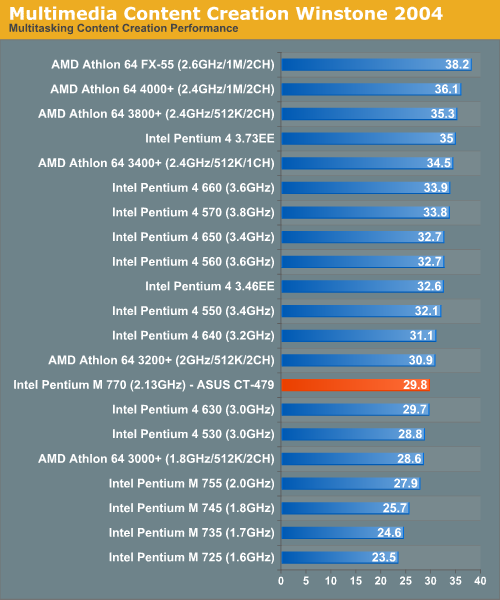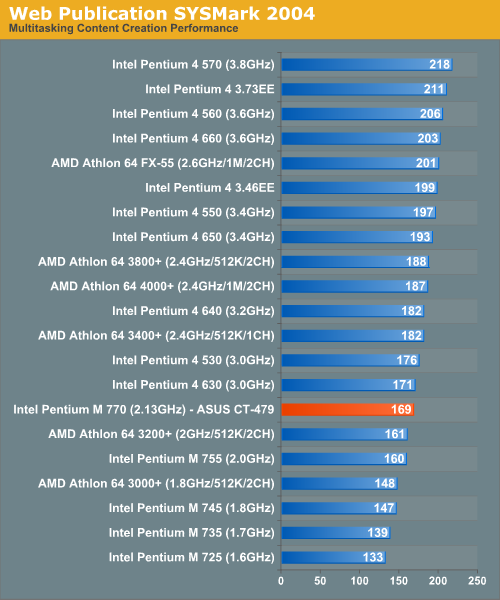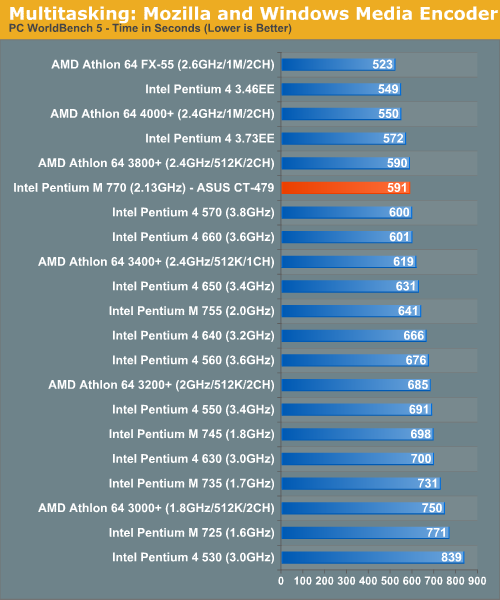Intel's Pentium M Desktop Part II: ASUS' Pentium M to Pentium 4 Socket Adapter
by Anand Lal Shimpi on March 24, 2005 1:31 PM EST- Posted in
- CPUs
Multitasking Content Creation
MCC Winstone 2004
Multimedia Content Creation Winstone 2004 tests the following applications in various usage scenarios:- Adobe® Photoshop® 7.0.1
- Adobe® Premiere® 6.50
- Macromedia® Director MX 9.0
- Macromedia® Dreamweaver MX 6.1
- Microsoft® Windows MediaTM Encoder 9 Version 9.00.00.2980
- NewTek's LightWave® 3D 7.5b
- SteinbergTM WaveLabTM 4.0f

ICC SYSMark 2004
The first category that we will deal with is 3D Content Creation. The tests that make up this benchmark are described below:"The user renders a 3D model to a bitmap using 3ds max 5.1, while preparing web pages in Dreamweaver MX. Then the user renders a 3D animation in a vector graphics format."

Next, we have 2D Content Creation performance:
"The user uses Premiere 6.5 to create a movie from several raw input movie cuts and sound cuts and starts exporting it. While waiting on this operation, the user imports the rendered image into Photoshop 7.01, modifies it and saves the results. Once the movie is assembled, the user edits it and creates special effects using After Effects 5.5."

The Internet Content Creation suite is rounded up with a Web Publishing performance test:
"The user extracts content from an archive using WinZip 8.1. Meanwhile, he uses Flash MX to open the exported 3D vector graphics file. He modifies it by including other pictures and optimizes it for faster animation. The final movie with the special effects is then compressed using Windows Media Encoder 9 series in a format that can be broadcast over broadband Internet. The web site is given the final touches in Dreamweaver MX and the system is scanned by VirusScan 7.0."

Mozilla + Media Encoder











48 Comments
View All Comments
Avalon - Thursday, March 24, 2005 - link
In Soviet Russia, the Pentium-M owns you!In all seriousness, though...I was reading the benchmarks and wondering where the 855GME desktop P-M 770 benchmarks were. You only had the 770 on the Asus board. While this is all fine and dandy, it doesn't show us the full extent of the benefits of the Asus pin adapter over using an 855GME desktop board. While you could extra some data, I would have liked 770 desktop benches as a comparison. All in all, though, the Asus adapter is definitely nice due to the price alone.
Wonga - Thursday, March 24, 2005 - link
I don't think anyone can criticise Intel too harshly for releasing the Netburst architecture. Yes, Willamet stank, and Prescott isn't exactly an efficient core, but a Northwood processor was the best CPU money could buy for about 18 months before the K8 hit the scene. So, it doesn't really matter how Intel got there, but Netburst was the architecture to have for those 18 months.Anyway, Anand, I'd appreciate it if you could see if those adaptors would work on other S478 motherboards :)
Oh, and thanks for a great article! Perhaps that Pentium M horse that was beaten so much can now finally rest in peace!
sprockkets - Thursday, March 24, 2005 - link
While the boards and tech mentioned here are nice, why not also test some of the PM mini-itx boards at www.logicsupply.com and see how badly it can kick an Mac Mini's ass? OR, how well it can perform in such small space with little heat and noise output?xtknight - Thursday, March 24, 2005 - link
amazing it beats the fx-55 at q3 source compile. maybe i need to get my eyes checked but does that say INTEL?mkruer - Thursday, March 24, 2005 - link
Here is what I get out of this,1. P-M is better clock then the P4 and apparently the AMD64, (at least in some applications)
2. Future versions of the P-M while adding better FP and SSEx Instructions will still not have 64-bit technology.
3. Adding better FP and SSEx, will also increase the minimal thermal rating, resulting in a lower maximum over clocking ability, and higher heat dissipation
All and all, it looks to be about the same as AMD64, when all the upgrades are added in.
ncage - Thursday, March 24, 2005 - link
#5 It probably wouldn't be that good for intel to drop Pentium M prices. Yes there would get more sales from techies like us but that wouldn't increase there sales that much. Where they get sales would be from labtops and their profit margins would drop for that that is why overall it would be stupid for intel to drop the prices on them.mlittl3 - Thursday, March 24, 2005 - link
I'm sorry but I have to say a few more things.I counted up all the benchmarks (not including overclocking ones) and the 2.13 GHz PM beats a 3.2 GHz PIV in 22 out of 33 benchmarks. For a 1 GHz+ underclocked processor, the PM wins in two-thirds of the benchmarks. Now correct me if I'm wrong but doesn't the 2.13 GHz PM consume 25W of power and the 3.2 GHz PIV consume around 100W. That's four times the power for 66% less performance.
Multiply that 4x waste by all the PIV's that Intel sold and we must have wasted megawatts upon megawatts of power for nothing. You can't say its technology improving because the PM is based on old technology.
Intel wasted so much electricity and polluted so much more of the environment because what it couldn't save face when it released the 1.13 GHz coppermine PIII and had to recall it because of architectural problems. Therefore, it had to release the PIV to make itself look better from a marketing standpoint.
This just blows my mind.
EODetroit - Thursday, March 24, 2005 - link
Nice article. While now we know that the Pentium M probably isn't practical for the desktop in most situations when price is considered, this review is important because it gives us something to compare the Yonah processors to when they come out. And those of us that were curious about the P-M on the desktop finally have some answers, so thanks for that.How high could it overclock, anyways? It sounded like you got it up to the point where the memory would be at DDR400 with the 5:4 ratio, and called it good. But how much more can it be pushed? What about with better cooling?
Googer - Thursday, March 24, 2005 - link
Thank God there are no Russian Jokes on this page!Googer - Thursday, March 24, 2005 - link
I did not see any benchmarks of the Pentium M 770 on the 855GME so we could compaire APPLES to APPLES the only system it was run on was 865, It's a bit of an unbalanced compairison. Anand, Just how much of a differance does 865 offer the P-M 770 over 855?